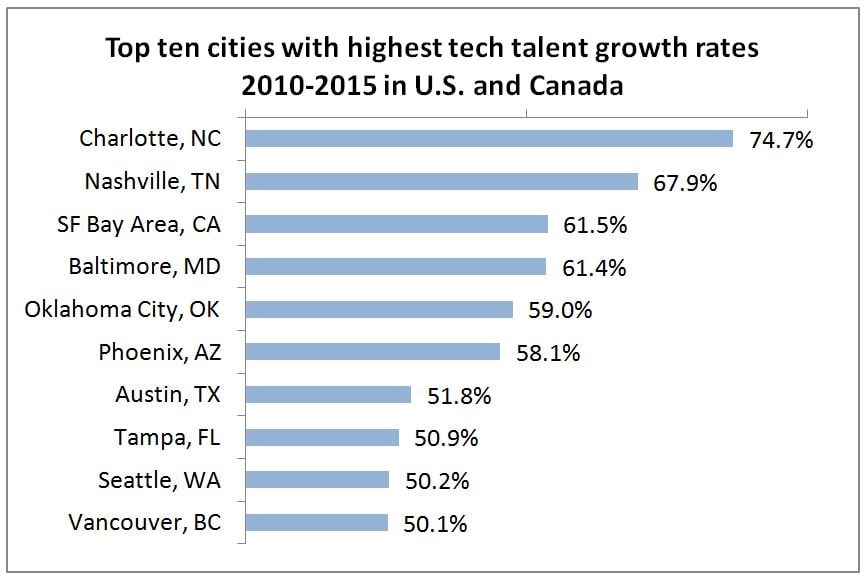Tracking tech talent – of which millennials form an increasing proportion – can be a useful barometer of how trends in labor markets affect cities, such as shaping the demand for commercial and residential real estate.
Tech-savvy workers account for 3.5 percent (4.8 million) of the total United States labor force, and include highly-skilled professionals such as software developers, coders and programmers, hardware engineers, and technical and support managers.
However, while it may only represent a small minority of America’s labor market, many see tech talent as one of the strongest drivers of economic recovery, fueling innovation and pushing up productivity.
A new report – that scores cities in the U.S. and Canada according to their ability to attract and grow tech talent – shows, unsurprisingly, that San Francisco is still America’s leading tech market.
However, it reveals that cities where the cost of living is lower, and tech jobs are plentiful, are also rapidly attracting highly skilled tech workers – millennials especially.
Millennials are the generation born between 1980 and 2000 and now entering employment in vast numbers. They already account for around a quarter of the U.S. workforce.
Small tech talent markets growing faster
CBRE’s 2016 Scoring Tech Talent report shows that American tech jobs grew by 27 percent or 1 million during 2010-2015.
Of the largest tech talent markets, the San Francisco Bay Area had the highest increase (61.5 percent) closely followed by Baltimore (61.4 percent).
But among the small markets (under 50,000 tech jobs), are cities that grew tech jobs much faster in the last 5 years. Charlotte, NC, grew by over 74 percent in the last 5 years, followed by Nashville, TN, at just under 68 percent.
 Small markets – e.g. Charlotte, Nashville, and Oklahoma City – dominate the list of top ten cities in the U.S. and Canada that showed the fastest tech talent growth rate during 2010-2015, particularly of millennials. (Data from CBRE report Scoring Tech Talent 2016.)
Small markets – e.g. Charlotte, Nashville, and Oklahoma City – dominate the list of top ten cities in the U.S. and Canada that showed the fastest tech talent growth rate during 2010-2015, particularly of millennials. (Data from CBRE report Scoring Tech Talent 2016.)
The report compilers used 13 factors to gauge the ability of markets to attract, grow, and retain pools of tech talent. They then analyzed and ranked 50 markets in the U.S. and Canada according to their score on the 13 metrics.
The 13 measures covered tech talent supply, growth, concentration, cost, and completed tech degrees. They also included outlook for job growth, and market outlook for growth in costs of both office and apartment space.
Colin Yasukochi, who wrote the report for CBRE Research, says:
“Tech talent markets share several distinct characteristics, including high concentrations of college-educated workers, major universities producing tech graduates and large millennial populations.”
“The robust entrance of millennials into the labor pool contributed greatly to the growth in tech talent across all 50 downtown markets in our ranking this year,” he adds.
Increasing numbers of millennials in the tech talent pool is being felt in two ways – a push toward more creative office spaces and a migration of tech companies toward less traditional, secondary tech markets. These tend to have cheaper office and private spaces that are more in line with millennials’ aspirations.
Millennials matter
Millennials matter because they have different expectations about work and work-life balance than previous generations. They are also more numerous than any generation since the soon-to-retire baby boomers.
By 2020, millennials will make up 40-50 percent of the American workforce. A 2014 study for the White House discusses how millennials are likely to impact the U.S. economy, due to factors such as:
– Millennials have been shaped by technology
– More millennials have a college degree than any other generation of young adults
– They value creativity in their work
– Millennials tend to get married later than previous generations
– They value community and family
– College-educated millennials tend to move to urban areas faster than their less-educated peers
While previous generations have been concerned about work-life balance, millennials are equally concerned about seamless integration between the two.
Inseparable from their smartphones, they can do everything from one place – from checking emails and uploading reports to banking, ordering meals, and catching up with friends on social media.
The effect is to shift working patterns from 9-5 to 24/7. Companies keen to attract tech talent are transforming to accommodate this, incorporating gyms, libraries, and game rooms.
The result, is that offices are starting look more like homes.
